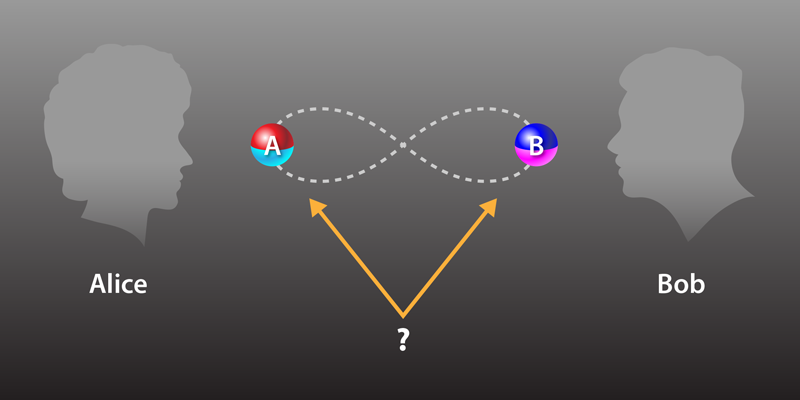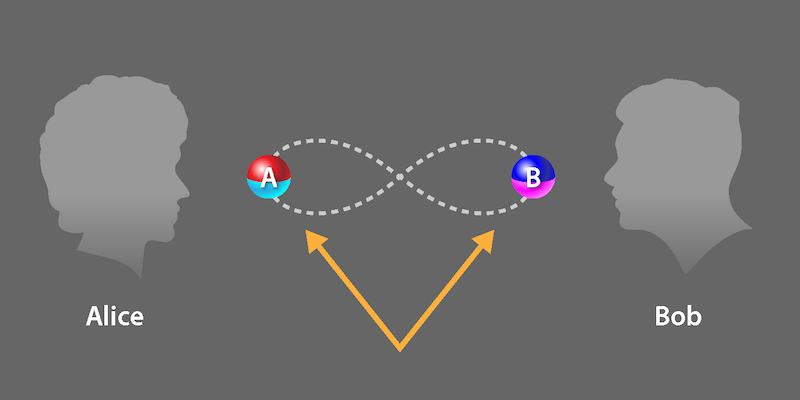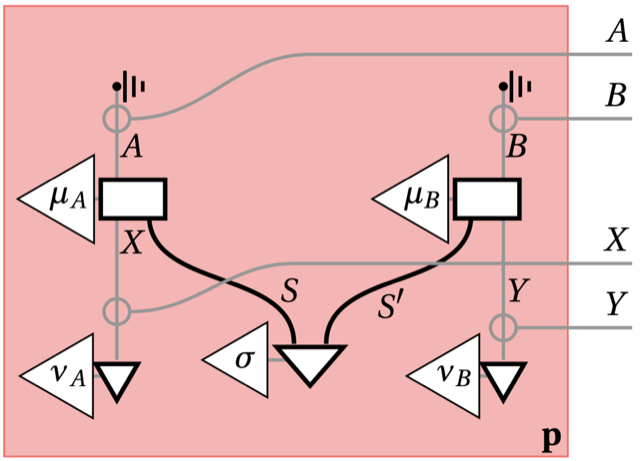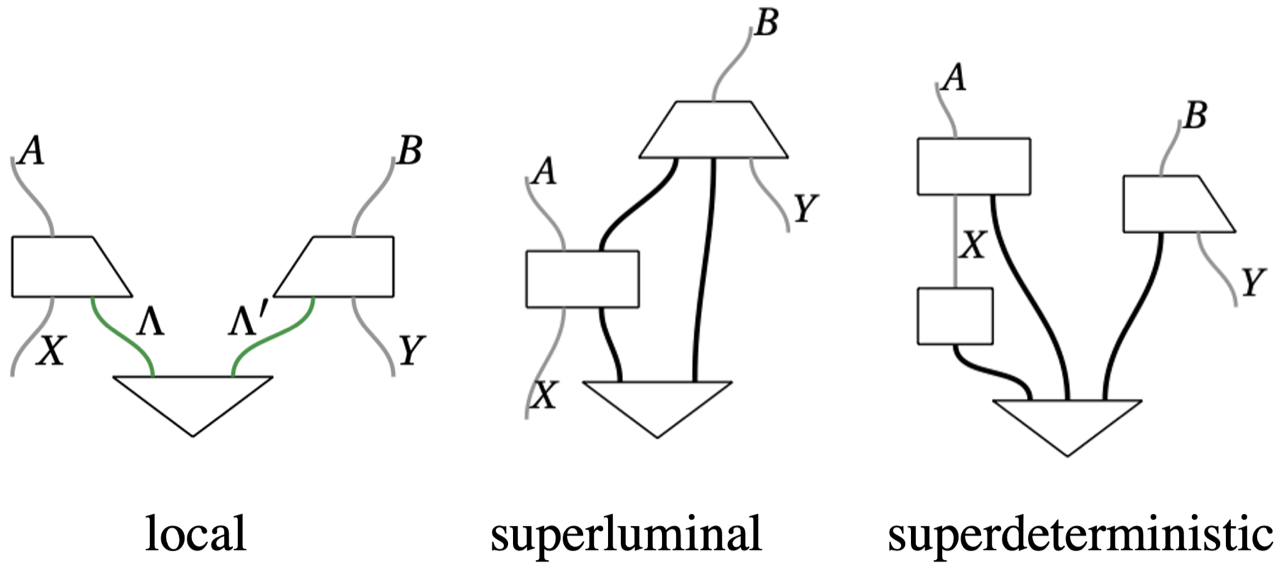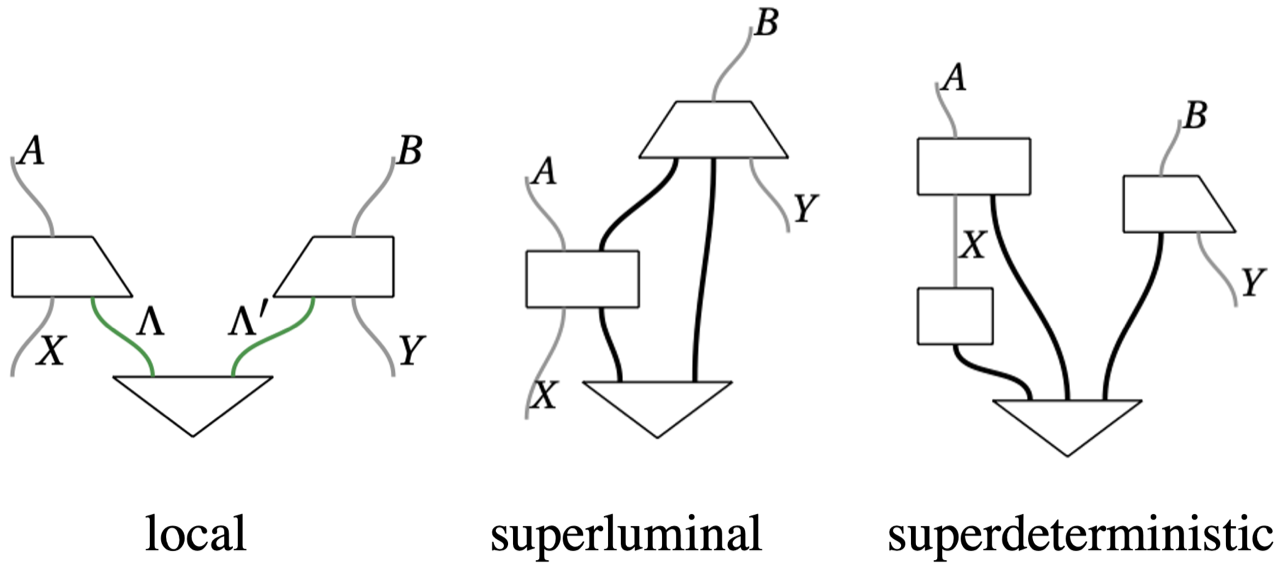Diagramming Quantum Weirdness
When faced with weird quantum effects, many physicists are content to just calculate the probabilities of experimental outcomes using the Schrödinger wave equation. But does that approach explain why particles behave like waves or how entanglement is maintained over large distances? Or is the math just a computational tool that hides our lack of a fundamental understanding of quantum phenomena? Researchers working on the foundations of physics are hoping to reveal a causal explanation of quantum mechanics by diagramming the elements within an experiment.
Everyone would agree that the Schrödinger equation and similar mathematical representations are powerful tools for predicting measurement outcomes (see Viewpoint: Quantum Mechanics Must Be Complex). However, most physicists believe that a measurement corresponds to “something” that exists regardless of being observed. “Deep down they are realists; they think there’s a world out there,” says David Schmid from the International Centre for Theory of Quantum Technologies in Poland. That might not seem surprising, but the problem is that Bell’s theorem—laid out in 1964 by the physicist John Stewart Bell—ruled out “local realism” (see Viewpoint: Closing the Door on Einstein and Bohr’s Quantum Debate). The Bell ruling means that a particle can’t carry with it, locally, a “hidden variable” that determines measurement outcomes.
So, what causes the particle to behave the way it does? Schmid and his colleagues are working on a new mathematical formalism that they hope will lead to a “quantum realism” that respects the Bell theorem while also appealing to our classical intuition. Schmid presented this work at the 20th European Conference on Foundations of Physics held last fall in Paris.
The formalism that Schmid and co-workers are developing can be understood as a method for interpreting quantum experiments such as the Bell test. The Bell test involves entangling two particles and then distributing them to two observers, Alice and Bob, who are separated by a large distance. Alice chooses to measure some property of her particle—say, the spin along the horizontal direction—and Bob independently chooses to measure the spin of his particle in another direction. The statistics of the two outcomes show a correlation, which can be captured by the Schrödinger equation. But this math doesn’t explain particular outcomes, like Bob recording spin-up during one run of the experiment (see Viewpoint: Causality in the Quantum World). “It’s unclear whether the wave equation actually gives a causal explanation of what’s going on,” Schmid says.
Causal explanations are desirable, Schmid says, because they let us understand how interventions lead to changes, distinguishing correlation from causation. For example, knowing that taking a drug is correlated with recovering from an illness does not imply causation, nor does it teach us what would happen if the drug were used to treat a different illness. But extracting a casual explanation of how the drug works can enable us to answer such questions.
Physicists and philosophers have proposed several types of causal explanations for quantum physics. One option is to assume that particles communicate with each other through some sort of superluminal signal (what Albert Einstein called “spooky action at a distance”). Another possibility is a superdeterministic framework in which all the parts of the experiment (including Alice and Bob’s measurement choices) were pre-determined by a single cause that occurred long ago. Other quantum interpretations include many-world theories (in which the Universe “splits” into two paths at each measurement) and relational quantum mechanics (in which reality is subjective, with Alice and Bob experiencing different worlds).
“None of these interpretations have gained a majority following among physicists,” Schmid says. The reason for this reluctance, he thinks, is that these interpretations require accepting a radical idea that doesn’t fit into our everyday experience of the world. “Each of these interpretations picks a poison and asks you to drink it,” Schmid says. That “poison” could be violations of relativity theory or the existence of many worlds. Schmid and his colleagues are looking for a more “palatable” alternative—a quantum realism that resembles classical realism.
The team’s approach is to allow for new types of mathematical inputs and operations in descriptions of the experiments. The common description of the Bell test, for example, would represent a particle by a classical random variable, say 0 or 1. That variable would serve as an input to a function that describes the measurement devices that Alice and Bob use. Schmid and colleagues abandon classical random variables and conventional functions and propose replacing them with other mathematical entities. This strategy is similar to recent proposals for defining quantum causal models. But there is, so far, no consensus on what the alternative mathematical entities are. “We don’t yet have precise mathematical proposals,” Schmid says, “but we have a framework for describing what the scope of possibilities is.”
The researchers’ framework comes from a method for diagramming quantum experiments, which is similar to how an engineer might diagram an electrical circuit. The mathematical entities—the inputs and operations—are represented by lines and boxes. This pictorial method makes clear the distinction between causal links (which are oriented vertically) and subjective inferences (which are oriented horizontally). The former makes up the causal structure of a realist model, while the latter embodies the information that observers like Alice and Bob are able to glean from their measurements.
The idea of diagramming quantum physics has been around for decades, says philosopher Alexei Grinbaum from CEA-Saclay in France. He is impressed by the effort of Schmid and colleagues to incorporate causal relationships and a realist picture within their diagrams. But he questions whether this complex mixture will reveal new insights. “If a result isn’t simple, people won’t get it,” Grinbaum says.
Schmid and his colleagues are trying to distill a simplified picture from their diagrams. They have so far devised diagram-based rules resembling the logical rules that are the basis of classical realism. They have also shown that their formalism can avoid the constraints placed on quantum realism by the Bell test and other so-called no-go theorems (see Viewpoint: Mind the (Quantum) Context). “In the end, we hope to be left with a theory that is nonclassical but still has the basic features that let you reason causally about the world in the ways that you want to,” Schmid says.
–Michael Schirber
Michael Schirber is a Corresponding Editor for Physics Magazine based in Lyon, France.



